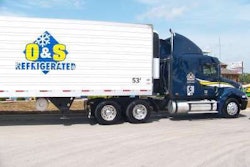Agency believes greenhouse gases harm public health
The U.S. Environmental Protection Agency last month issued a proposed finding that emissions of six specific greenhouse gases contribute to air pollution that may endanger public health or welfare within the meaning of the Clean Air Act. The action followed a U.S. Supreme Court decision that ordered a scientific review of the issue.
By a 5-4 decision in April 2007, the court also rejected the U.S. Environmental Protection Agency’s argument that Congress’ delegation of authority for fuel economy to the U.S. Department of Transportation prevented EPA from regulating motor vehicle emissions of carbon dioxide. The fact “that DOT sets mileage standards in no way licenses EPA to shirk its environmental responsibilities,” the court said.
In response, EPA Administrator Lisa Jackson also is proposing to find that the combined emissions of carbon dioxide, methane, nitrous oxide and hydrofluorocarbons from new motor vehicles and new motor vehicle engines are contributing to the mix of greenhouse gases in the atmosphere and, therefore, to air pollution that endangers public health and welfare. The two other greenhouse gases included in the proposed finding – perfluorocarbons and sulfur hexafluoride – are not emitted by motor vehicles.
If finalized, EPA’s proposed findings could give the agency broad authority to regulate greenhouse gas emissions, including those from motor vehicles. EPA said the science shows that concentrations of these gases are at unprecedented levels as a result of human emissions and that these high levels are very likely the cause of the increase in average temperatures and other changes in our climate.
Climate change, in turn, affects human health in several ways, EPA says. One recent study concluded that climate change may lead to higher concentrations of ground-level ozone, a harmful pollutant. Other potential impacts may include increased drought, more flooding, more frequent and intense heat waves and wildfires, greater sea level rise, more intense storms and harm to water resources, agriculture, wildlife and ecosystems, EPA concluded. In addition, climate change has national security implications due to destabilization resulting from scarce resources, such as water, the agency said.
The proposed finding does not include any proposed regulations. EPA said it would conduct an appropriate process and consider stakeholder input before taking steps to reduce greenhouse gases. The agency also reiterated President Obama’s preference for legislation to address greenhouse gases. EPA has scheduled public hearings this month on its proposed finding – May 18 in Arlington, Va., and May 21 in Seattle.
For more information, go to www.epa.gov/climatechange/endangerment.html. Comments and other information also are available at www.regulations.gov by searching EPA-HQ-OAR-2009-0171.
Revised figures show fewer job losses
The trucking industry shed nearly 15,000 jobs – or 1.1 percent of the total – on a seasonally adjusted basis in March, according to preliminary estimates released in early April by the U.S. Department of Labor’s Bureau of Labor Statistics. Seasonally adjusted employment is down 8.4 percent since March 2008.
Perhaps more interesting and significant than the March numbers, however, is the agency’s revision of its January and February employment estimates to show a far smaller job loss for trucking than BLS had reported a month ago.
According to the revised estimates, seasonally adjusted payroll employment for truck transportation dropped 1.3 percent and 1 percent in January and February, respectively, from the prior month. While still among the greatest monthly declines on record, those drops are much smaller than the 1.8 percent and 2.5 percent decreases based on the preliminary numbers reported in March.
Based on the latest adjusted numbers, the trucking industry has lost about 45,000 jobs, or 3.4 percent, since the end of 2008. By contrast, the March jobs report showed a decline of 58,000 jobs, or 4.3 percent, in January and February alone.
On an unadjusted basis, the 0.5 percent drop in March was the smallest since the 0.4 percent increase posted in August. Most observers, however, focus on seasonally adjusted numbers as more representative of economic trends given that the unadjusted numbers often reflect sharp fluctuations due to weather, holidays and so on.
FMCSA tightens policy on fines
Motor carriers likely will face maximum penalties more often under a new enforcement policy that took effect April 1. In a March 30 Federal Register notice, the Federal Motor Carrier Safety Administration announced a supplemental policy that will change how it now will implement Section 222 of the Motor Carrier Safety Improvement Act of 1999. Section 222 requires FMCSA to assess maximum statutory penalties if a person or company is found to have committed a pattern of violations of critical or acute regulations, or previously committed the same or a related violation of critical or acute regulations.
Until now, FMCSA has defined “pattern of violations” and “previously committed the same or related violation” as three cases closed with findings of violation occurring within the last six years. The “three strikes” also could be two cases that have closed followed by a third case in which violations were discovered during a compliance review or similar audit.
In recent years, both the Government Accountability Office and the U.S. Department of Transportation’s Office of Inspector General have faulted FMCSA’s approach toward implementing the 1999 legislation. For example, GAO recommended a “two strikes” policy and a meaning of “pattern of violations” that is distinct from repeated violations of the same regulation. OIG recommended that FMCSA count all acute and critical violations discovered during a compliance review.
Based on these recommendations, FMCSA re-examined its policy. FMCSA now will define “pattern of violations” as occurring when the agency discovers two or more critical and/or acute violations in each of three or more different regulatory parts. A “pattern of violations” will not require a previous enforcement and can be found even during a first-time investigation.
Maximum fines may be implemented based on previous contact with FMCSA, a state motor carrier safety enforcement agency or other FMCSA-designated representative. Such contact includes a wide range of events, including new entrant safety audit, pre-authorization safety audits, expedited action letters, compliance reviews, notices of violation, notices of claim, warning letters “or other significant documented contact reasonably likely to have alerted the motor carrier to FMCSA’s regulatory and enforcement jurisdiction.” The previous contact may have occurred prior to April 1, 2009, FMCSA said. However, a roadside inspection alone is not considered “a previous contact.”
‘Two strikes’ policy
FMCSA also is adopting a “two strikes” policy that is similar to the existing “three strikes” policy. FMCSA will apply maximum penalties in cases where an acute violation is discovered during an investigation within six years of a previously closed case that contained a finding of violation of a critical or acute regulation in the same part of the federal motor carrier or hazardous materials regulations. FMCSA will apply the same standards as it did under the “three strikes” policy.
The supplemental policy also expands the category of investigations during which violations subject to maximum penalties may be discovered. Investigations now will include rated and unrated compliance reviews, terminal reviews, shipper reviews, focused reviews, on- and off-site assessment investigations, and on- and off-site investigations arising under the agency’s Comprehensive Safety Analysis 2010 program or successor programs. The CSA 2010 program, currently under evaluation, would rely on more frequent intervention by FMCSA and its agents than under the current compliance review-based approach.
The new policy might prove more generous to carriers in one respect: settlements. Under a policy that had been in effect since late 2004, FMCSA had barred any settlement of maximum penalties, although payment plans were allowed. Now, the agency says it will allow FMCSA Service Centers to evaluate Section 222 maximum penalties on a case-by-case basis.
FMCSA will use the new “two strikes” policy only for investigations and cases initiated on or after April 1, 2009. Investigations and cases initiated prior to that date will continue to be considered for maximum penalty assessment under the “three strikes” policy.
In Brief
U.S. District Court for the District of Columbia last month upheld the Clean Trucks Program (CTP) at the Los Angeles and Long Beach ports, rejecting a request by the Federal Maritime Commission for an injunction. The decision is unrelated to the March ruling by the U.S. Court of Appeals for the Ninth Circuit, which sided with the American Trucking Associations in its challenge of the ports’ concession agreements. (See “Journal,” April 2009.) In fact, ATA is not even challenging the CTP, which sets a schedule for replacement or retrofit of older diesel engines.
U.S. Court of Appeals for the Ninth Circuit dismissed as moot a challenge to the Bush administration’s cross-border trucking demonstration project. The court heard arguments in the lawsuit in February 2008, but never ruled in the case. Congress killed the program in March by explicitly denying funding for the existing program.
U.S. Transportation Security Administration is reminding workers who require unescorted access to secure areas of maritime facilities and vessels, as well as all U.S. credentialed mariners, that the nationwide Transportation Worker Identification Credential (TWIC) compliance took effect April 15. For more information, go to http://twicinformation.tsa.dhs.gov.
University of Michigan Transportation Research Institute will host an international conference June 15-17 on efficient, safe and sustainable truck transportation systems. The event, called “Building the Policy Options Roadmap,” features speakers and sessions on the extent and future direction of domestic and international freight and technical sessions focusing on technologies and operational practices that address productivity, the environment, safety and infrastructure. For more information, go to
www.magictrucks.org.
Port of Oakland, Calif., board authorized $2 million to help truck owners purchase diesel particulate filters to reduce emissions at the port and another $3 million to help drayage truck owners meet new state retrofit regulations that begin to take effect next year.
Freight Transportation Services Index rose 2.0 percent in February from its January level, according to the U.S. Department of Transportation’s Bureau of Transportation Statistics. The February increase – only the second since August – still leaves the index at its second-lowest point since September 2003.













